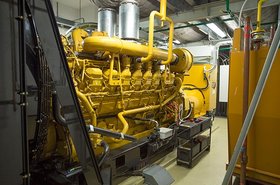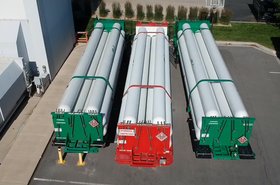These are busy times in the global data center market. Megatrends such as 5G, the Internet of Things and cloud computing are continuing to drive up demand for new build data center infrastructure – from edge and colocation, through to hyperscale.
Buoyancy in the sector has been given additional impetus due to the pausing last year of many newbuild projects following the sudden emergence of the pandemic.
Developments put on hold are now coming back onstream, as data center operators invest heavily to meet rapidly expanding demand for digital services.
Indeed, according to the latest research by Gartner, end-user spending on global data infrastructure is expected to reach $200 billion in 2021, an increase of 6 percent from 2020. This rebound will gather pace over the next four to five years, it adds.
Overcoming data center supply chain challenges
For data center suppliers, rapid market growth offers both opportunity and threat. On the one hand, the expansion in activity brings new business opportunities, as data center operators look to replicate projects in other countries and regions. However, lead times on some critical systems have already been extended out to six to nine months, as production facilities that were scaled back last year struggle to ramp up to meet rapidly increasing demand.
This pressure on supply chains is problematic – as multi-million-dollar data center builds operate on carefully orchestrated schedules, with major systems and components supplied in strictly sequential order. Failure to deliver on time and to specification can cause significant knock-on effects, risking the project’s overall budget and schedules.
So, what can data center suppliers do to ensure that schedules are met during periods of heightened demand, while ensuring that quality and reliability remain consistently high?
Here at Kohler, the answer comes with an unstinting commitment to a culture of repetitive processes and continuous improvement within our main production facility in Brest, northwest France. This has enabled us to dramatically accelerate the output of generators for the data centers without compromising production standards. As a result, we have kept control of lead times, while other global suppliers have struggled to keep up.
Instilling a culture of repetitive process
But what do a culture of repetitive processes and continuous improvement look like in practice – where it matters – out on the shop floor? In many ways, it resembles the sorts of actions more commonly found in the automotive sector, with a set of key deliverables guiding every step of the production process. This approach ensures repeatable build standards across all generator power nodes.
The first step is close collaboration with the customer’s procurement specialists, using the latest scheduling software, parts planning, and stockholding analysis to ensure that the project is de-risked. The aim, ultimately, is to make sure that all requirements on data center contracts are met, without fail, no matter the size or location of the project.
For applications such as large data centers, gensets are built in dedicated cells, with Kohler’s exclusive engines providing a crucial building block. The compact and powerful engines incorporate a modular design with a high degree of common components, allowing for efficient servicing, reduced spare parts inventory, and more streamlined technician training. Having access to exclusive engines shortens and simplifies supply chains and ensures that Kohler always has the components needed to meet rising demand.
A rigorous global procurement policy is also essential to ensure that all component and system suppliers undergo strict performance measurement – with GAP analysis and dedicated follow-up taskforces to ensure that consistent standards are met. Something like a regular score-card assessment covering factors such as quality is used and a yearly business continuity plan checks that suppliers are in good shape for the future. The aim is to protect supply-chain reliability and minimize the risk of delays.
Continuous improvement in action
Once parts and materials arrive, they should be logged with serial/batch numbers to ensure full traceability, before a five-stage process comprising mechanical coupling, mechanical assembly, electrical assembly, testing, finishing, and final inspection takes place.
At all stages, programme leaders monitor key performance metrics across each day to ensure that quality standards are consistent and that the project schedule does not slip. This expectation is met through sustained investment in continuous improvement – identifying opportunities to streamline work and reduce waste. At every step of the generator-build process, incremental advances are sought to improve performance and deliver results.
For example, at our Brest facility, huddle meetings and continuous improvement (CI) cards foster a culture of openness across the plant. Team leaders and shopfloor workers have stand-up meetings at the start of each shift, providing an opportunity for any concerns to be discussed. The card system encourages employees to propose any continuous improvement suggestions. This initiative recently identified some difficulties that shopfloor operatives of varying heights were encountering when performing specific tasks. An ergonomic working group was created, resulting in the installation of fully adjustable workstations.
A handy framework for this approach would be the Japanese 5S quality tool – translated to sort; set in order; shine; standardize; and sustain. This creates an orderly and well-maintained facility, where everything has its place. Smart toolboxes and cabinets are arranged to enable employees to work in the most efficient way. The shopfloor has demarcated zones throughout, optimizing the movement of people and products. Glass walls and screens are arranged so that visual management systems can be seen by all. 5S encourages a culture of accountability.
On a bigger scale, process flow software can be deployed to visualize and optimize the movements of equipment and people around the plant. This cutting-edge technique is deployed to analyse traffic congestion and eliminate any potential bottlenecks on the factory floor. Simulation-based process software can be used on specific projects, where required, to improve operational efficiency by reducing and to enhance safety standards.
Health and safety is critical
Finally, the whole ethos of repetitive processes and continuous improvement should be underpinned by a ‘zero-is-possible’ (ZIP) approach to workplace safety, with an injury prevention programme (IPP) put in place across the plant.
With accident hotspots identified and analysed, plant managers can predict where issues might occur and avoid injuries and delays to production. At Kohler, this starts on the plant floor with a ZIP card system which encourages workers to flag any potential issues on a daily basis. As a result, new processes/safety measures such as safety tours, education on best practice and even equipment upgrades can be implemented to drive improvements without delay.





